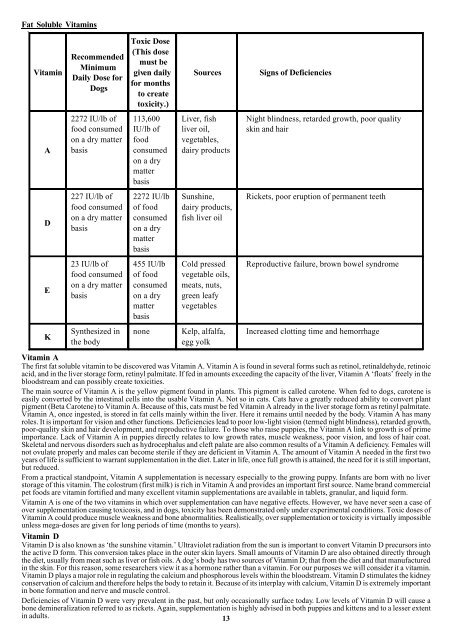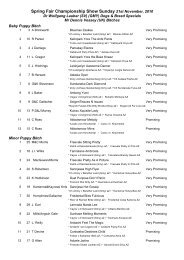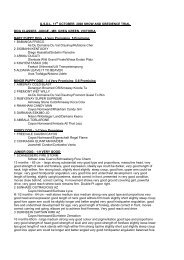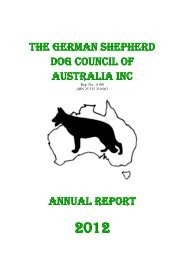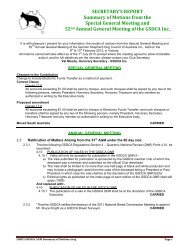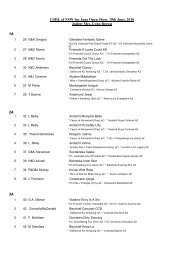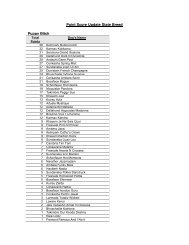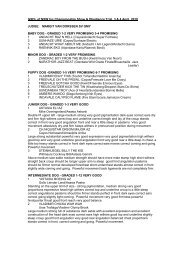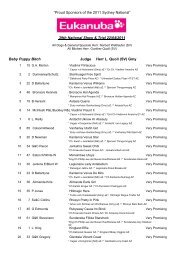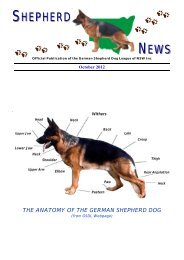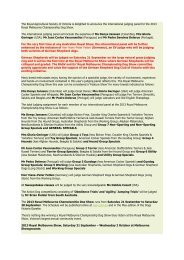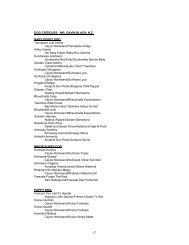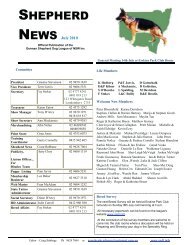Shepherd News 2 - German Shepherd Dog League NSW Inc.
Shepherd News 2 - German Shepherd Dog League NSW Inc.
Shepherd News 2 - German Shepherd Dog League NSW Inc.
You also want an ePaper? Increase the reach of your titles
YUMPU automatically turns print PDFs into web optimized ePapers that Google loves.
Fat Soluble Vitamins<br />
Vitamin<br />
A<br />
D<br />
E<br />
K<br />
Recommended<br />
Minimum<br />
Daily Dose for<br />
<strong>Dog</strong>s<br />
2272 IU/lb of<br />
food consumed<br />
on a dry matter<br />
basis<br />
227 IU/lb of<br />
food consumed<br />
on a dry matter<br />
basis<br />
23 IU/lb of<br />
food consumed<br />
on a dry matter<br />
basis<br />
Synthesized in<br />
the body<br />
Toxic Dose<br />
(This dose<br />
must be<br />
given daily<br />
for months<br />
to create<br />
toxicity.)<br />
113,600<br />
IU/lb of<br />
food<br />
consumed<br />
on a dry<br />
matter<br />
basis<br />
2272 IU/lb<br />
of food<br />
consumed<br />
on a dry<br />
matter<br />
basis<br />
455 IU/lb<br />
of food<br />
consumed<br />
on a dry<br />
matter<br />
basis<br />
none<br />
Sources<br />
Liver, fish<br />
liver oil,<br />
vegetables,<br />
dairy products<br />
Sunshine,<br />
dairy products,<br />
fish liver oil<br />
Cold pressed<br />
vegetable oils,<br />
meats, nuts,<br />
green leafy<br />
vegetables<br />
Kelp, alfalfa,<br />
egg yolk<br />
Signs of Deficiencies<br />
Night blindness, retarded growth, poor quality<br />
skin and hair<br />
Rickets, poor eruption of permanent teeth<br />
Reproductive failure, brown bowel syndrome<br />
<strong>Inc</strong>reased clotting time and hemorrhage<br />
Vitamin A<br />
The first fat soluble vitamin to be discovered was Vitamin A. Vitamin A is found in several forms such as retinol, retinaldehyde, retinoic<br />
acid, and in the liver storage form, retinyl palmitate. If fed in amounts exceeding the capacity of the liver, Vitamin A ‘floats’ freely in the<br />
bloodstream and can possibly create toxicities.<br />
The main source of Vitamin A is the yellow pigment found in plants. This pigment is called carotene. When fed to dogs, carotene is<br />
easily converted by the intestinal cells into the usable Vitamin A. Not so in cats. Cats have a greatly reduced ability to convert plant<br />
pigment (Beta Carotene) to Vitamin A. Because of this, cats must be fed Vitamin A already in the liver storage form as retinyl palmitate.<br />
Vitamin A, once ingested, is stored in fat cells mainly within the liver. Here it remains until needed by the body. Vitamin A has many<br />
roles. It is important for vision and other functions. Deficiencies lead to poor low-light vision (termed night blindness), retarded growth,<br />
poor-quality skin and hair development, and reproductive failure. To those who raise puppies, the Vitamin A link to growth is of prime<br />
importance. Lack of Vitamin A in puppies directly relates to low growth rates, muscle weakness, poor vision, and loss of hair coat.<br />
Skeletal and nervous disorders such as hydrocephalus and cleft palate are also common results of a Vitamin A deficiency. Females will<br />
not ovulate properly and males can become sterile if they are deficient in Vitamin A. The amount of Vitamin A needed in the first two<br />
years of life is sufficient to warrant supplementation in the diet. Later in life, once full growth is attained, the need for it is still important,<br />
but reduced.<br />
From a practical standpoint, Vitamin A supplementation is necessary especially to the growing puppy. Infants are born with no liver<br />
storage of this vitamin. The colostrum (first milk) is rich in Vitamin A and provides an important first source. Name brand commercial<br />
pet foods are vitamin fortified and many excellent vitamin supplementations are available in tablets, granular, and liquid form.<br />
Vitamin A is one of the two vitamins in which over supplementation can have negative effects. However, we have never seen a case of<br />
over supplementation causing toxicosis, and in dogs, toxicity has been demonstrated only under experimental conditions. Toxic doses of<br />
Vitamin A could produce muscle weakness and bone abnormalities. Realistically, over supplementation or toxicity is virtually impossible<br />
unless mega-doses are given for long periods of time (months to years).<br />
Vitamin D<br />
Vitamin D is also known as ‘the sunshine vitamin.’ Ultraviolet radiation from the sun is important to convert Vitamin D precursors into<br />
the active D form. This conversion takes place in the outer skin layers. Small amounts of Vitamin D are also obtained directly through<br />
the diet, usually from meat such as liver or fish oils. A dog’s body has two sources of Vitamin D; that from the diet and that manufactured<br />
in the skin. For this reason, some researchers view it as a hormone rather than a vitamin. For our purposes we will consider it a vitamin.<br />
Vitamin D plays a major role in regulating the calcium and phosphorous levels within the bloodstream. Vitamin D stimulates the kidney<br />
conservation of calcium and therefore helps the body to retain it. Because of its interplay with calcium, Vitamin D is extremely important<br />
in bone formation and nerve and muscle control.<br />
Deficiencies of Vitamin D were very prevalent in the past, but only occasionally surface today. Low levels of Vitamin D will cause a<br />
bone demineralization referred to as rickets. Again, supplementation is highly advised in both puppies and kittens and to a lesser extent<br />
in adults. 13


